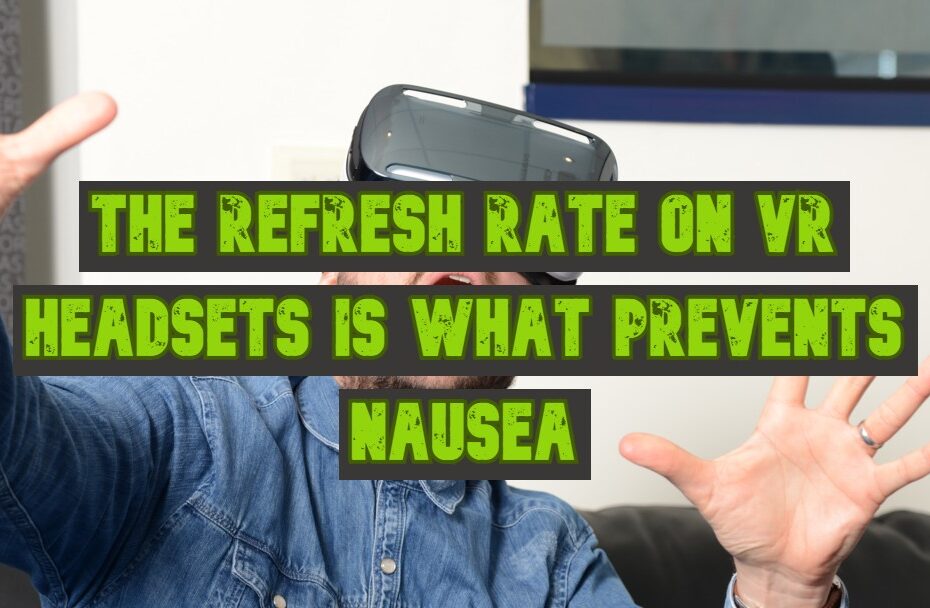Concerning VR screens, if you think about it – what are they? They’re still just a screen of sorts and nothing more. The refresh rate is not actually ‘what makes it look smooth’ as that would be giving them too much credit.
You might say that the refresh rate makes it look smoother, but that is not actually a good thing. I’d argue that, in fact, it makes things look less smooth because of how the human eye works.
When looking at a screen or other 2D image, the human eye cannot distinguish between one frame and another. The human brain fills in the gaps because of how our neural pathways work – it creates an illusion that the world moves smoothly. On the other hand, when you look at a real-life scene with your eyes, it is not only moving slightly from one frame to the next (as our brain fills in) but also has depth. The brain does not get an opportunity to fill in gaps between frames because of the lack of depth. So in a way, if you have a screen with a high refresh rate trying to make the world seem more smooth by adding frames between each other – this actually leads to an effect where it looks less smooth because of how the brain processes it.
Many People Get Nausea From Playing Virtual Reality Headsets
In fact, humans are the only species that become nauseous at all. Nausea is interesting because it prevents certain actions and behaviors (eating) when harmful to an organism’s survival or fitness. Nausea is often caused by a conflict between visual input (‘I should eat this, it’s good for me’) and olfactory input (‘this smells bad, I must avoid it’).
For mammals in general (including humans), nausea is not pleasant but rather an inconvenience that can be overcome through conditioning. In fact, most organisms do not experience nausea at all, as they lack the neural circuitry to process that feeling. Nausea is a feeling which evolved in humans, but it has no actual inherent value. It only exists to prevent actions that would be bad for survival/fitness, and many of those actions are now unnecessary or even harmful.
The Smooth Illusion in VR is from the Refresh Rate
The human experience is built from the inside out. Nothing has meaning outside of this human subjectivity. What appears smooth to a person may appear choppy and broken when viewed by another species with different sensory organs. For example, we do not have eyes with high enough resolution to see the individual pixels on a screen. Rather, we have brains that smooth over the edges of visual information.
The fact that we cannot see the individual pixels means they experience a smooth image. But does this mean there is no pixelation? No, it simply means that we do not experience this. The smoothness of the image is an illusion. It is created by a brain that hides the visual artifacts from view. However, this does not mean that there are no visual artifacts. Similarly, we experience a sense of continuity and coherence in time that is actually created by their brain’s interpretation of the high refresh rate.
The temporal resolution of the human mind (and body) is much lower than that of computers. When we perceive the world, we create a picture of reality by sampling it with their sensors and then processing this information with their brains. The limitations of human perception mean that this process is not perfect.
The Higher The Refresh, The Less Nausea
The smoothness on screens is from a high refresh rate. It’s what gives the screen a ‘clean’ feel. It is also why screens can flicker on and off at an extremely rapid rate. This is because they can change their brightness faster than our eyes can see. This is a fascinating subject. Our eyes can see something when it changes rapidly. This seems to be a trait of the human eye, as many insects eat at very high rates.
The refresh rate is the time period in which display updates. To be human is to have a higher refresh rate than the surrounding environment. The brain is the most powerful processor in existence. It has a refresh rate of zero and always processes as fast as possible. The brain is the only processor that doesn’t have a refresh rate, as it operates at its maximum speed.
Conclusion: Faster Refresh Rates Reduce Nausea
There are still other elements of virtual reality experiences and gameplay that can cause nausea in players. However, the motion sickness related form of nausea is vastly improved from using WMR VR Headsets with high refresh rates. This is simply because the difference between what motion your brain sees and what your body is doing is reduces to nearly zero. Having huge input delays between actions from the controller or headset is the only way you can still get this type of motion sickness.
The newer VR Headsets that have come out have nearly zero input delay between the controllers and what you see. Likewise, there is nearly zero input delay between your head movements and what your brain experiences. If your VR Headset is good enough, or if your graphics card is powerful enough, you will have a high enough refresh rate to minimize nausea from motion sickness entirely!
